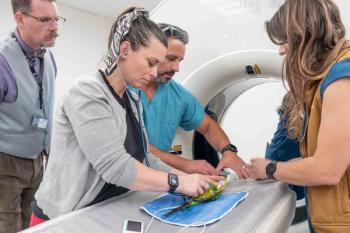
Small animal thoracic radiology: Pulmonary edema vs. pleural effusion (lines and buckets) (Proceedings)
Pulmonary patterns have the bane of radiology since the beginning (1896 that is). The most difficult concept to teach and the most difficult to learn, yet, the pattern itself is only part of the puzzle. The recognition that the disease is actual within the pulmonary parenchyma and not in the pleural space, extrathoracic structures or the mediastinum is the first step.
Pulmonary patterns have the bane of radiology since the beginning (1896 that is). The most difficult concept to teach and the most difficult to learn, yet, the pattern itself is only part of the puzzle. The recognition that the disease is actual within the pulmonary parenchyma and not in the pleural space, extrathoracic structures or the mediastinum is the first step. To this end we will review a basic interpretation paradigm and look at the steps for evaluating the thoracic radiograph in dogs and cats. Technique and positioning are critical in this process and should be the cornerstone for high quality thoracic radiographs. Finally, we will tackle pulmonary patterns with an emphasis on describing what is on the thoracic radiographs and equally important, recognizing anything that is missing.
Objectives of the Presentation
1. Understand the different radiographic features of pleural effusion and pulmonary edema (cardiogenic and non-cardiogenic).
2. Recognize potential pitfalls in the interpretation of multicompartmental disease of the thorax (e.g., diseases that involve both the pleural space and the pulmonary parenchyma).
3. Understand the difference between a lobar sign and pleural fluid within a fissure between lung lobes.
4. Think in terms of next step and how to get a cytologic diagnosis in as non-invasive a fashion as possible.
Key Etiologic and Pathophysiologic Points
1. Technical factors including technique, phase of respiration and the positioning of the patient have to be taken into account when interpreting thoracic radiographs.
2. Radiographic abnormalities are non-specific and one must thing in terms of what the next step would be to reach a definitive diagnosis.
3. The pathophysiology of many pulmonary diseases do not equate with a specific pulmonary pattern.
Key Clinical Diagnostic Points
1. One should try to compartmentalize radiographic abnormalities into extrathoracic, pleural, pulmonary and mediastinal (including cardiac), recognizing that any disease can have multicompartmental components.
2. One should try to determine the anatomic location of pathology within the lung first and foremost and then worry about the pulmonary pattern. Even though there may be several pulmonary patterns, one must identify the dominant pattern in order to evaluate for differentials.
3. Pleural effusions should always be evaluated using cytology and culture and sensitivity unless post trauma and the effusion (assumed to be hemorrhage) is resolving over several days.
Key Therapeutic Points
1. Follow-up radiographs should be obtained in rapid succession if warranted (within the same day or within 24 to 48 hours).
2. Edema from cardiogenic causes respond rapidly to diuretics unless the dog or cat has been in chronic failure and is resistant to the diuretics.
3. Edema from non-cardiogenic causes will not clear rapidly, but may take several days to see significant resolution of pulmonary abnormalities.
Key Prognostic Points
1. Bi-cavitary effusions (pleural and peritoneal) carry a poor prognosis.
Interpretation Paradigm
The thoracic radiographs should be made on peak inspiration and should be centered over the heart so that the thoracic inlet and the caudal dorsal lung lobes are obtained on the same radiograph. This may not be possible with a 14" x 17" on a large breed dog (Great Dane), in which case two cassettes are required for each view (cranial thorax and caudal thorax) making sure there is overlap in the middle. The images to be make include a dorsoventral or ventrodorsal and a right and left lateral. The three view thorax has become the standard of care in veterinary medicine so do not leave yourself short. The technique used is typically a high kVP and low mAs technique with the highest mA and fastest time station being used to obtain mAs techniques in the 1 to 3 range. For a small dog or cat, the kVP may still be in the 50 to 60 range.
Positioning is critical for accurate interpretation. The ventrodorsal should be straight with the sternum lined up with the thoracic vertebrae and the rib heads should be overlapping on the laterals. Sometimes a triangular sponge is required to lift the sternum away from the table on the lateral radiographs in order to get the sternum and spine parallel to each other prior to taking the radiograph. Peak inspiration means that the cupola of the diaphragm is drawn caudal to the cardiac silhouette and the caudal dorsal lung margins reach to the level of T12-13 in dogs and T13-L1 in cats. An expiratory radiograph will negatively impact your interpretation skills in two primary ways. First, the heart will always look big relative to the overall thoracic volume and second, the lungs will look "whiter" than normal. If you take only right lateral radiographs of small dogs, that present for a cough, and the radiograph is made on expiration, the dog will have a big heart and pulmonary edema every time (both are "fake-outs!"). If you were to take the DV or VD you would see that the thorax is really normal.
External artifacts (skin folds, nipples, etc.) must be recognized and not attributed to pulmonary pathology. Expiration, under exposure and obesity will all increase the overall lung opacity, thereby falsely thinking that one is dealing with pulmonary edema or some type of pulmonary pathology as previously state.
Pleural Effusion versus Pulmonary Edema
A pleural effusion is the abnormal accumulation of fluid within the pleural space (the potential space located between the visceral and parietal pleural surfaces). Pleural effusions can be caused by a transudate, modified transudate or an exudate. Pulmonary edema is the abnormal accumulation of fluid within the interstitial space of the pulmonary parenchyma. This can spread to the point of being alveolar in location as well. The radiographic features of pleural effusions are distinct and should not be confused with pulmonary edema.
Normal Anatomy of the Pleural Space and Lung Lobes
The pleural space exists between each lung lobe at the interlobar fissure. Normally, these fissures are not seen on thoracic radiographs. Occasionally, fat will deposit in a fissure thereby separating the two lung lobes at a fissure (most commonly between the right cranial and right middle lung lobes as seen on a VD/DV radiograph). The fissures occur in classic anatomic positions and one should be familiar with these positions as well as the basic anatomic shape of the lung lobes, themselves. Each lung lobe has a distinct location where the fissure is normally positioned. On each lateral radiograph, there is a dorsal fissure located around T6 between the cranial and caudal lung lobes. Each bronchus should try to be identified on each radiographic view. On the laterals, the down lobe bronchi may be difficult to see (right middle bronchus on a right lateral radiograph is often difficult to visualize). The right cranial lung lobe bronchus exits the caudal thoracic trachea dorsal to the heart base, takes a 90 degree turn in a ventral and cranial direction. The left cranial lung lobe bronchus exits the ventral trachea just before the carina. Within a cm from the origin, the bronchus divides into the cranial and caudal sub segmental bronchi of the left cranial lung lobe bronchus. Just after the carina, the right middle lung lobe bronchus originates from the floor of the lateral aspect of the right caudal lobe bronchus. Finally, the right accessory lung lobe bronchus originates from the right caudal lobe bronchus 2 to 3 cm from the carina in a ventromedial position.
Thoracic Interpretation Paradigm
The thoracic radiograph can be approached using a four-compartment model with the extrathoracic structures being evaluated first. This includes the sternum, ribs, thoracic limbs, cervical and thoracic vertebrae, diaphragm and cranial abdominal structures and surrounding soft tissues. The second area for evaluation is the potential pleural space. Each area of interlobar fissure is evaluated for abnormal widening with air or fluid or retraction of the visceral pleural lung surface away from the parietal pleural surface of the thoracic wall. The pulmonary parenchyma is then evaluated which includes the airways and vessels. The mediastinum is the last compartment and can be divided into cranial, middle and caudal parts. The cranial mediastinum includes the ventral cranial mediastinal reflection between the right cranial and left cranial lung lobes, cranial mediastinal structures (lymph nodes, esophagus, trachea, vessels, nerves and lymphatics) and fat. The middle mediastinum contains the heart, tracheal termination (carina), tracheobronchial lymph nodes and esophagus. The caudal mediastinum contains vessels, lymphatics, the caudal thoracic esophagus and the caudal vena cava within the plica vena cava of the accessory lung lobe. Initially, one should try to compartmentalize abnormalities into a given area and then start to break down the specifics (start general then work toward the specific abnormalities). In complex, disease processes, more than one compartment may be involved.
Pleural Space – Normal or Abnormal?
There are several questions to ask about the pleural space, if you believe it is abnormal. Is there pleural fluid or pleural air? Are there any extrapleural signs or mass(es)? Are the ribs and bony structures of the thorax normal? If the answer is yes to any of these questions, then specific descriptors of the abnormality are then appropriate. For example, there is a large, expansile, mass associated with the right 7th rib that causes medial retraction of the pleural space and lung margins with a moderate volume of focal pleural effusion. An extrapleural sign is an area of increased soft tissue opacity within the "lung field" that is being caused by indentation from an extrapleural structure. This could be a normal structure (e.g., costochondral junction of a Bassett Hound) or a primary abnormality (rib fracture or rib tumor).
The radiographic diagnosis of pleural effusion is based on the following radiographic abnormalities. Soft tissue opacity or fluid accumulation will be present within the interlobar fissures. These fissures will be widest peripherally and will be thinner centrally. There will be rounding or blunting of the costophrenic and lumbodiaphragmatic angles. There will be border effacement with the cardiac silhouette and diaphragm. With severe pleural effusions, dorsal elevation of the trachea may be present. Unilateral effusions are secondary to exudates as the mediastinum in dogs and cats is considered fenestrated. This being said a transudate or a modified transudate should pass freely between the right and left pleural space through the mediastinal fenestrations. These fenestrations will be plugged with any exudative effusion resulting in an unilateral pleural effusion (chylothorax, pyothorax, hemothorax or neoplastic effusion). In a reactive, exudative effusion such as secondary to a chylothorax, there will be thickening of the visceral pleural surface with chronic rounding of the lung lobe margins. This restrictive pleuritis results in the inability of the lung lobes to re-inflate to their normal shape or volume. The differentials for a chronic pleural effusion that should not be ignored would include: chronic diaphragmatic hernia, pericardial effusion, thoracic malignancy (rib tumor being common) and right middle lung lobe torsions.
Pulmonary Edema
Pulmonary edema is the abnormal accumulation of fluid within the interstitial space of the lungs based on abnormalities of Starling's forces across the capillary bed and interstitium. Alterations in plasma albumin (plasma oncotic pressure), elevated venous hydrostatic pressure (elevated left atrial pressures), increased capillary permeability (membrane breakdown) and increased osmotic (oncotic) pressures within the interstitial space will all result in a net flow of fluid into the pulmonary interstitial space.
Pulmonary Lesion Description
The easiest thing to recognize in describing a pulmonary pattern is where the disease is located. Is the disease in a particular part of the thorax? Is it cranioventral vs. caudodorsal? Is the increased soft tissue pulmonary opacity central or hilar vs. peripheral? Which lung lobes are involved? Once you have described the anatomic position of the abnormal pulmonary opacity, evaluate the mediastinum on the VD radiograph. Is the heart and mediastinum in a normal central position or is there a mediastinal shift. If a mediastinal shift is present, it should be described as ipsilateral (movement of the heart or mediastinal structures toward an area of lung lobe volume loss) or contralateral (mass lesion pushing the heart and mediastinum away from the lesion). The third lesion description is the pulmonary pattern. Remember that lung pathology can be complex and have a variety of patterns present. Avoid jargon terms (infiltrate, consolidation and broncho-interstitial) and try to describe which pattern you believe to be the worst (most severe). Assign a level of severity (mild, moderate or severe) to the pulmonary pattern and then prioritize a differential list. Remember that pulmonary radiographic abnormalities are non-specific changes and other factors must be weighed in on the final prioritized differential diagnostic considerations.
Summary
Pulmonary edema should not be confused with pleural effusion. Although congestive heart failure can result in both, usually the disease processes are very different that will cause pulmonary edema versus a pleural effusion. The ability to recognize a pleural effusion is essential and based on pleural fissure lines with retraction of the visceral pleural surface away from the parietal surface. By dividing the thorax into four compartments, one should be able to confidently classify the disease processes based on their anatomic location and prioritize the differentials based on signalment, presenting complaints and the collection of radiographic abnormalities present.
• Technical quality impacts the ability to interpret thoracic radiographs
• A systematic approach to film review is critical for complete assessment
• Adequate time needs to be give to the review of thoracic radiographs
• Multicompartmental disease can be confusing at first, but take each compartment separately and then tie them together
• Pulmonary abnormalities should be described in terms of anatomic localization prior to a pulmonary pattern description
• Interpretation of thoracic radiographs is fun!
Suggested Reading/References
Thrall, DE. Veterinary Diagnostic Radiology, 5th Edition. WB Saunders: 2008.
Dennis R, Kirberger RM, Wrigley RH and Barr FJ. Handbook of Small Animal Radiological Differential Diagnosis, WB Saunders, 2001.
O'Brien RT. Thoracic Radiology for the Small Animal Practitioner, Teton NewMedia, 2001.
Schwarz T and Johnson V. BSAVA Manual of Canine and Feline Thoracic Imaging. BSAVA, 2008.
Newsletter
From exam room tips to practice management insights, get trusted veterinary news delivered straight to your inbox—subscribe to dvm360.






